
Out of Sight, Out of Mind: The Hidden Cost of Empty Shelves and Broken Displays
Executive Summary
A Closer Look conducted a comprehensive survey of 1,340 consumers to investigate the impact of product availability and display functionality on consumer behavior and retail performance. The findings highlight the critical importance of effective inventory management and functional in-store displays in today’s competitive retail landscape.
Empty shelves and non-functioning displays significantly influence customer satisfaction, purchase decisions, and brand loyalty, resulting in substantial revenue losses for retailers.
To mitigate these challenges and enhance customer experience, retailers must prioritize strategies that ensure consistent product availability, maintain functional displays, and provide alternative solutions when faced with out-of-stock situations. This approach is crucial for maximizing sales opportunities and fostering long-term customer relationships in an increasingly competitive retail environment.
Introduction
What happens when a customer can’t find what they’re looking for on store shelves? In today’s competitive retail landscape, product availability and functional in-store displays are crucial elements that can make or break a sale. At A Closer Look, we recognize the profound impact these factors have on customer satisfaction, brand loyalty, and ultimately, a retailer’s bottom line.
The retail industry is facing significant challenges in inventory management and product availability.
In 2018, retailers lost out on $300 million in revenue due to poor inventory management, and that was before the pandemic. Pre-pandemic, the odds of shoppers seeing an out-of-stock message were 1 in 200. That figure rose to 1 in 59 in 2022, a 235% increase. In 2021, 7.4% of retail sales were not realized due to out of stock items, which cost retailers $82 billion, per NielsenIQ data.

To quantify the impact of product availability and display functionality on consumer behavior and retailer success, we commissioned this Retail Display Availability Report. Our goal is to provide actionable insights into how out-of-stock situations and non-functioning displays affect customer satisfaction, purchase decisions, and ultimately, retailer revenue.
This report aims to explore:
- The frequency of out-of-stock experiences
- Consumer responses to unavailable products
- The impact on purchase decisions and store loyalty
- The role and effectiveness of in-store displays
- Variations across retail categories

Methodology
To gain comprehensive insights into retail display availability and its impact on consumer behavior, we conducted a survey of 1,340 consumers. This study focused on their experiences with product availability in retail stores and interactions with in-store displays. The survey consisted of multiple-choice questions and covered various aspects of the shopping experience related to product availability and display effectiveness.
Key Findings
Our analysis of the survey data provided valuable insights into four critical areas of retail operations and customer experience:
- The prevalence and impact of out-of-stock situations
- Consumer responses to product unavailability
- The influence of in-store displays on purchasing decisions
- Variations in product availability across retail categories
These findings offer a detailed picture of the challenges retailers face in maintaining optimal product availability and the potential consequences of failing to meet customer expectations. The following sections delve into each of these areas, providing actionable insights for retailers looking to enhance their inventory management and in-store display strategies.
Detailed Findings
1. The Prevalence of Out-of-Stock Experiences
To gauge the frequency of out-of-stock situations, we asked respondents how often they visit a store and find that an item they planned to purchase is unavailable. The results are concerning for retailers:
A staggering 81.1% of respondents reported encountering out-of-stock items either “Often” (19.3%) or “Sometimes” (61.8%). Only 18.3% seldom face this issue, while a mere 0.6% never experience it. This high frequency of stock issues presents a significant challenge for retailers, potentially leading to lost sales and diminished customer loyalty.
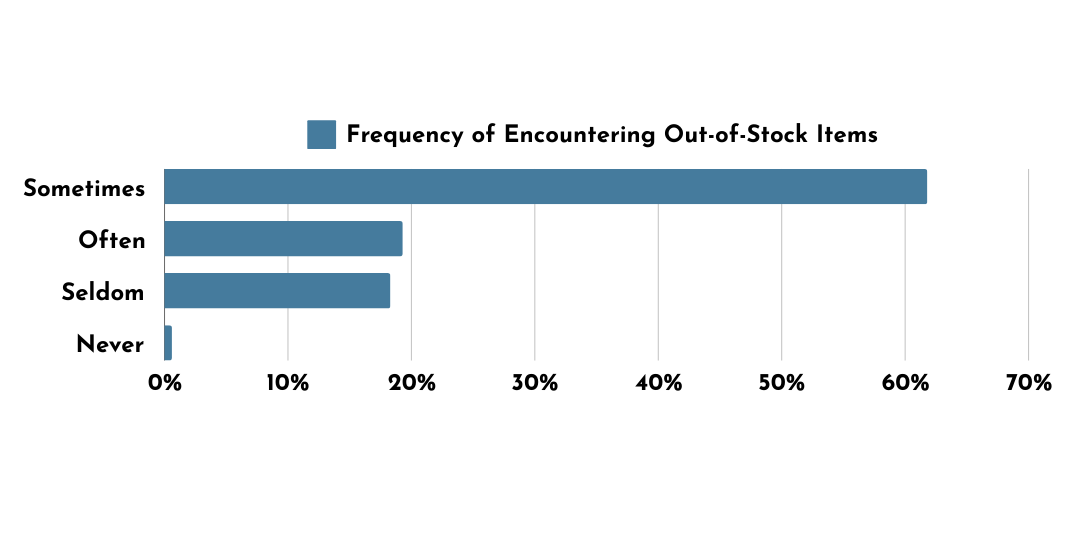
The commonality of out-of-stock experiences suggests that retailers are consistently failing to meet customer expectations. This gap between expectation and reality can erode trust and satisfaction, potentially driving customers to seek alternatives.
2. The Ripple Effect of Unavailable Products
We sought to understand the potential long-term impact of out-of-stock situations by asking respondents about their likelihood to return to a store where they couldn’t find what they wanted. The results should give retailers pause:
While 47.2% of respondents are either “Very likely” or “Likely” to return, a concerning 21.6% are either “Unlikely” or “Very unlikely” to do so. This represents a substantial risk of customer loss for retailers who frequently face stock issues.
Likelihood of Returning to the Store:

The data suggests that each out-of-stock experience doesn’t just cost the retailer a single sale – it could potentially result in the loss of a customer’s future business. This compounding effect amplifies the importance of maintaining consistent stock levels.
3. The Impact of Wasted Trips
To understand the consequences of more intentional shopping trips, we asked respondents how often they make a special trip to a store only to find their desired item out of stock. This scenario represents a particularly frustrating experience for customers:
75% of consumers experience this “Occasionally” or more frequently, with 21% facing it “Frequently” or “Very frequently.” These instances of unmet expectations can lead to frustration and potential loss of customer loyalty.
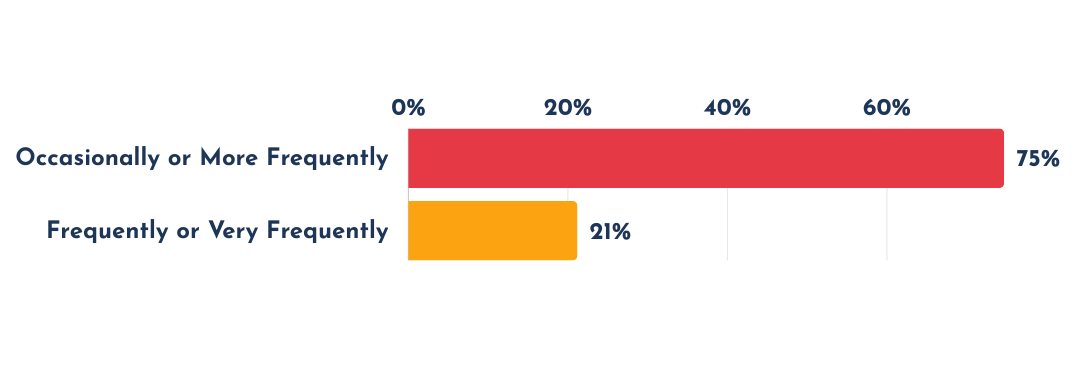
When a customer makes a dedicated trip to a store for a specific item, their disappointment in not finding it is likely to be more acute. This scenario not only wastes the customer’s time but also undermines their trust in the retailer’s reliability, potentially influencing future shopping decisions.
4. The Promotional Promise: Often Unfulfilled
We asked respondents about their experiences with the availability of sale or promotional items, as these often drive store visits and purchases:
The unavailability of sale or promotional items is a common occurrence, with 45.7% of consumers reporting that this happens “Always” or “Usually.” This not only leads to disappointed customers but also undermines the effectiveness of promotional strategies designed to drive foot traffic and sales.

When promotional items are consistently unavailable, it can create a sense of “bait and switch,” even if unintentional. This erodes customer trust and can negate the positive impact of sales and promotions, turning a potential boost in customer goodwill into a source of frustration.
5. The High Stakes of Empty Shelves
To understand how consumers react when faced with unavailable items, we asked about their subsequent actions. The results highlight the significant risks retailers face when items are out of stock:
- 57.2% look for the same product at another location
- 47.5% search for the product online
- 42.3% buy from third-party online retailers
- 34.3% forego the purchase entirely
- 31.6% switch to a different brand
Two-thirds of consumers forego a purchase or switch brands when items are out of stock.
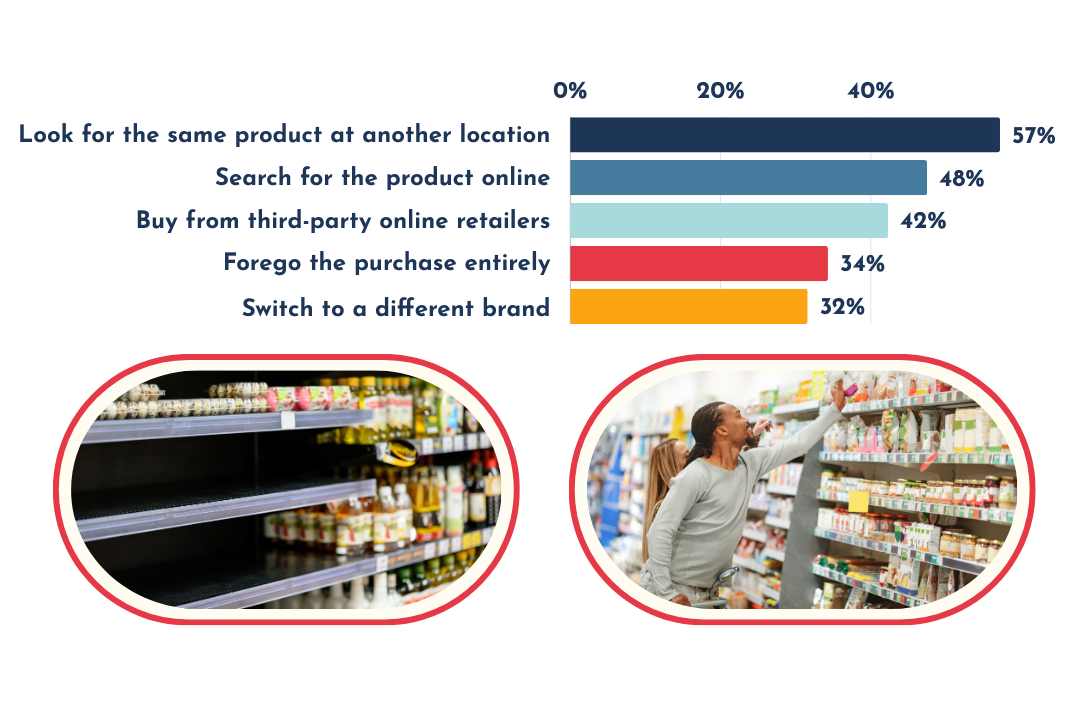
These figures underscore the multifaceted threat that out-of-stock situations pose to retailers. Not only do they risk losing the immediate sale, but they also face the possibility of losing the customer to a competitor’s physical location or online platform. The high percentage of consumers willing to buy from third-party online retailers is particularly concerning, as these sales often come with additional commission fees, eating into the brand’s profits.
Moreover, the fact that nearly a third of consumers are willing to switch brands highlights the fragility of brand loyalty in the face of unavailability. Each out-of-stock experience is an opportunity for a competitor to win over a customer.
Perhaps most alarming is that over a third of consumers simply abandon the purchase altogether. This represents a complete loss of potential revenue, with no guarantee that the customer will return to make the purchase later.
6. The Reliability Gap in Online Stock Information
In an age where many consumers check online before visiting a store, we asked respondents about their experiences with the accuracy of online stock information. The results reveal a concerning disconnect:
50.6% of respondents report that they “Very often” or “Sometimes” find items out of stock upon arrival, despite online indicators suggesting availability. This discrepancy can lead to wasted trips and frustrated customers.
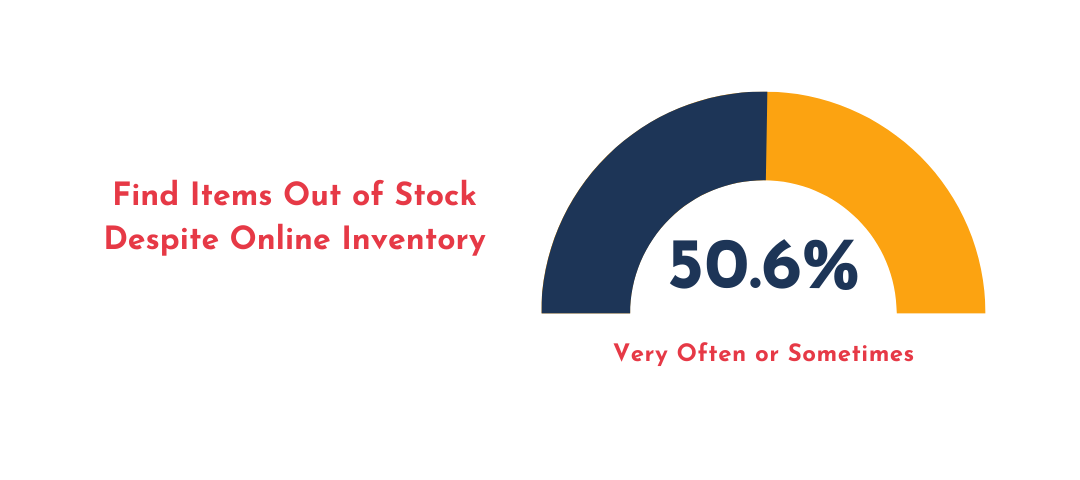
This reliability gap not only wastes customers’ time but also erodes trust in the retailer’s online presence. As consumers increasingly rely on digital information to inform their shopping decisions, inaccurate stock information can significantly damage a retailer’s reputation and lead to lost sales opportunities.
7. Category-Specific Out-of-Stock Experiences
To help retailers focus their inventory management efforts, we asked respondents in which retail categories they most frequently encounter out-of-stock items:
Grocery stores face the highest incidence of out-of-stock items (60.9%), followed by Health and Wellness (9.2%) and Household Supplies (8.8%). This data can help retailers prioritize their inventory management efforts on the most problematic categories.
The high percentage in the grocery category is particularly noteworthy, as these are often essential items that drive frequent store visits. Consistent availability issues in this category could significantly impact customer loyalty and store preference.

8. The Power of In-Store Displays
To understand the potential impact of in-store displays, we asked respondents about their likelihood to use these displays when shopping. The results underscore the significant role that in-store displays, when working properly, can play in the retail environment:
46.9% of respondents are either “Very likely” or “Likely” to use in-store displays. This high engagement rate highlights the potential of in-store displays as powerful sales tools that can significantly influence customer behavior at the point of purchase.
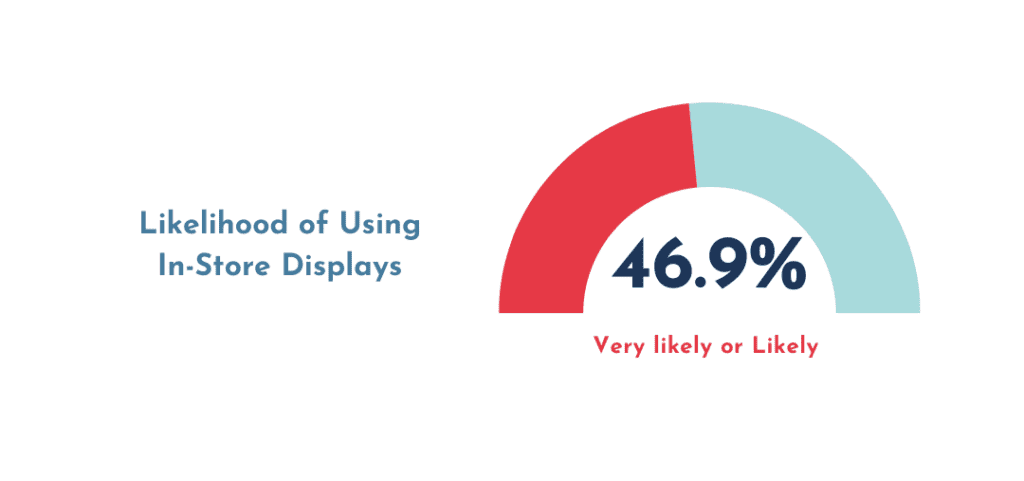
In-store displays serve multiple purposes in the retail ecosystem. They can draw attention to new products, highlight special promotions, showcase product features, and create an interactive experience for shoppers. By effectively leveraging these displays, retailers can guide customer attention, provide additional product information, and ultimately drive sales.
The data suggests that nearly half of all shoppers are actively engaging with in-store displays, making them a critical touchpoint in the customer journey. For retailers, this represents a valuable opportunity to communicate directly with customers, reinforce brand messages, and influence purchasing decisions in real-time.
Moreover, well-executed displays can enhance the overall shopping experience, making it more engaging and informative for customers. This can lead to increased customer satisfaction, longer browsing times, and potentially higher average transaction values.
9. The Functionality Challenge of In-Store Displays
We also inquired about the functionality of demo products in in-store displays, a key factor in their effectiveness: 29.2% of respondents encounter non-functioning demo products either “Very frequently” or “Frequently.” This high rate of malfunction can negatively impact the customer experience and potentially hinder sales.

Non-functioning displays not only fail to showcase products effectively but can also create a negative impression of the product or brand. This underscores the importance of regular maintenance and updates for in-store displays to ensure they consistently provide value to customers and drive sales.
From Insights to Action: Bridging the Availability Gap
Our report highlights the critical importance of effective inventory management and functional in-store displays. The high frequency of out-of-stock experiences, coupled with their negative impact on customer return likelihood, poses a significant threat to retailer revenue and customer loyalty.
The data suggests that retailers must prioritize improving their inventory management systems, particularly in high-risk categories like groceries. Additionally, ensuring the reliability of online stock information and maintaining functional in-store displays are crucial areas for improvement.
For today’s retail brands, real-time insights into store conditions are more valuable than ever. Tools that provide immediate visual feedback on product availability and display conditions can be game-changers, allowing retailers to respond quickly to issues and maintain optimal shopping experiences. By leveraging innovative retail technology, brands can stay ahead of potential problems and ensure that customers always find what they’re looking for.
To truly address these challenges and create meaningful improvements, retailers must prioritize collecting and acting on customer feedback. By implementing a multi-faceted approach to gathering customer insights, including mystery shopping, SMS-enabled feedback programs, focus groups, and innovative tools like real-time visual data collection, retailers can gain a comprehensive understanding of their performance across all aspects of the shopping experience.
Armed with this knowledge, retailers can make data-driven decisions to optimize their inventory management, improve the effectiveness of their in-store displays, and enhance overall customer satisfaction. By consistently monitoring and responding to customer feedback, retailers can identify emerging trends, address issues proactively, and create shopping experiences that truly resonate with their target audience.
By addressing these issues and embracing innovative solutions, retailers can enhance customer satisfaction, reduce lost sales opportunities, and foster long-term customer loyalty in an increasingly competitive retail landscape. Ultimately, the retailers who succeed will be those who not only stock their shelves effectively but also actively listen to and act upon the voices of their customers.
Like these reports? Learn more about conducting Focused Feedback Surveys with A Closer Look’s first-party consumer database, or with your own brand’s customers, to gain insights about consumer behaviors and trends.
Contact A Closer Look today to learn about tools that optimize your inventory management and in-store display strategies for greater customer satisfaction and revenue.